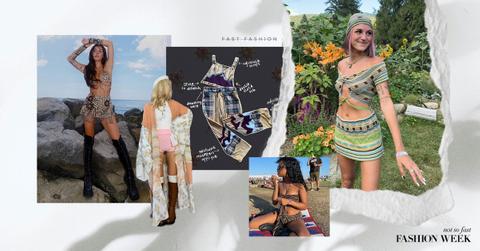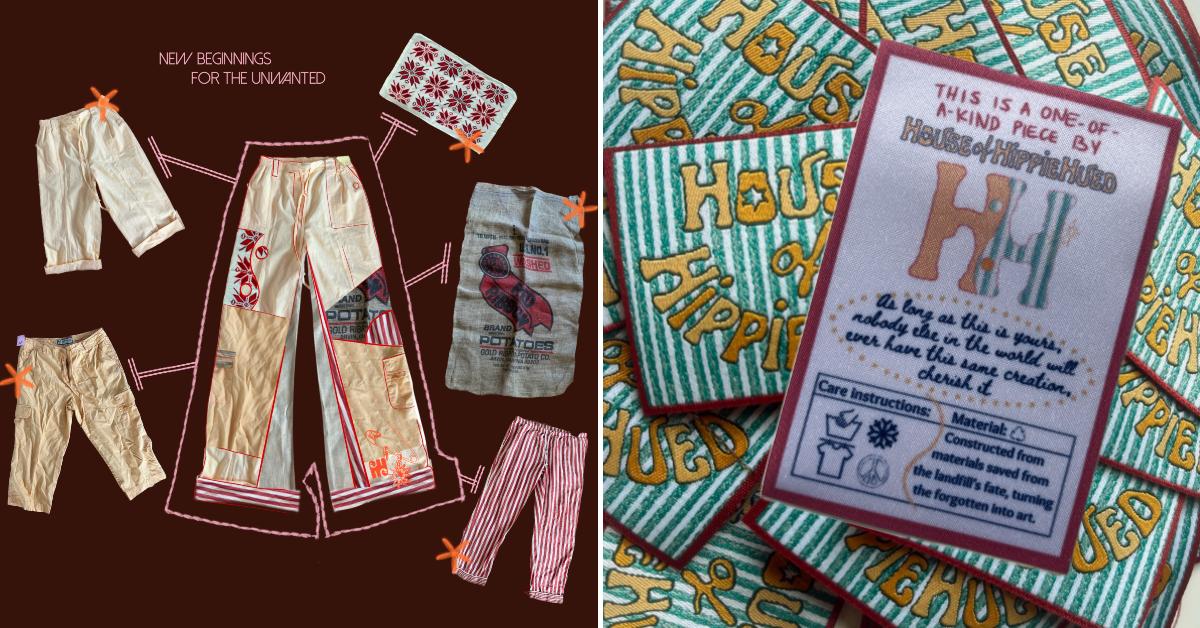Rave, Don’t Rage Against the Planet — These Upcycling Designers Slay Sustainable Festival Wear (Exclusive)
"The mass production of cheap and trendy festival pieces consumes enormous amounts of water, energy, and raw materials."
Published Sept. 10 2024, 10:30 a.m. ET

Almost 20 years later, The Devil Wears Prada cerulean monologue holds up. Meryl Streep's iconic fashion sermon not only highlights the power of the fashion industry but also offers commentary on how unique looks can be commodified into fast fashion.
Sadly, those in the rave, concert, and music festival scenes are particularly vulnerable to purchasing on-theme fossil fuel-based, microplastic-releasing ensembles and accessories. That alien headpiece and kandi collection will end up in a landfill, along with the Taylor Swift beaded friendship bracelets, pink felt Chappell Roan-inspired cowboy hats, Love on Tour feather boas, et cetera.
As per The Fashion Law, in 2019, U.K.-based survey consultancy Censuswide found that "single-use outfits for music festivals ... account for approximately $307 million worth of items per year or about 7.5 million outfits."
Fashion cited The New York Times, writing that fast fashion behemoths like H&M and Asos “plan for months” ahead of the profitable festival season.
"It's a huge trend in the festival scene to buy a new outfit for every event," upcycling designer, TikToker, and frequent festival-goer Brooklyn Karasack tells Green Matters via email. "I am a guilty participant of wearing a new outfit at every event, but it doesn't need to mean buying something new!"

TikTok is jam-packed with talented sustainable designers who specialize in themed costumes and festival wear, offering creative sets Frankensteined together from thrift finds, scrap fabric, and sometimes grandma's tablecloth.
For our Not so Fast Fashion Week campaign, Green Matters spoke exclusively via email with sustainable and upcycling designers Brooklyn Karasack, co-founder and co-designer of Controlled Chaos, Taylor Bratton, CEO and founder of Hippie Hued, Taya "TS," founder of Handmade by TS, and Payton Wilson, founder of Miss P Threads, about fighting the fast fashion influence at music events.
These interviews have been lightly edited and condensed for length and clarity.
GREEN MATTERS: How do you believe fast fashion impacts the music festival, rave, and concert scenes? How do you seek to change this?
BROOKLYN KARASACK: With my platform mostly being thrift flip tutorial-based, I think the best route for change involves more people using secondhand materials and learning to sew and upcycle. Additionally, I urge people to not forget the power of styling thrifted items, mixing and matching, and incorporating accessories to create "new" outfits.
TAYLOR BRATTON: Those "fun" festival outfits from brands like Shein, Temu, and Missguided have a true cost, as they're made in terrible conditions by workers facing unfair wages. They're often made out of synthetic fabrics that take over 200 years to decompose and shed microplastics that find their way into our oceans and bloodstreams.
With Hippie Hued, my mission is to combat fast fashion by upcycling and transforming old pieces into one-of-a-kind designs. I want people to see fashion not as something disposable, but as a way to express their individuality with pieces they can cherish for generations.
TAYA "TS": It does more harm than good. While there are outfit repeaters out there, they’re far and few between. Being able to buy something cheap makes it easier to discard. I offer custom outfits, which allows people to have an item catered to them, making it significantly more valuable.
PAYTON WILSON: The mass production of cheap and trendy festival pieces consumes enormous amounts of water, energy, and raw materials. Combined with rapidly changing trends, this large-scale production depletes our planet's natural resources at an unforgiving and unsustainable rate.
Rave culture thrives on uniqueness and authenticity, so seeing the same outfit repeatedly can diminish the spirit of self-expression that these events are meant to celebrate. I address this by sustainably sourcing all my materials from thrift stores for my business. I focus on finding less conventionally attractive pieces that might otherwise end up in a landfill and transforming them into unique, one-of-a-kind creations.
GM: How can the average person dress up on-theme for concerts and music events while respecting the planet?
BK: Thrifting is an obvious answer, but there are a ton of closet resale/swap/trade Facebook, Instagram, and Depop accounts where people resell the outfits they've bought or made for festivals. If you truly want to buy something new for a festival, shop small instead of going to fast fashion.
TB: At Hippie Hued, we love mixing colors, patterns, and textures that wouldn’t normally go together, but somehow blend seamlessly.
Of course, upcycled clothing often comes with a higher price point because of the time and love that goes into making each item. I get that not everyone’s ready to invest in that, so platforms like Depop, eBay, and Facebook Marketplace make secondhand shopping easy. Thrifting is usually cheapest, and there’s something so thrilling about searching for hidden treasures.
TS: Use items you already have in your closet! If I didn’t have time to create my outfit to see Chappell Roan, I had four backup vintage outfits already in my closet. Thrifting is the next best alternative! Find existing pieces to wear and/or upcycle that may otherwise end up in a landfill.
PW: Get inventive and customize your own outfits! Anyone can engage in DIY projects like painting clothes or adding embellishments. Opting for thrifted, vintage, or secondhand pieces is another great way to stand out while reducing textile waste. Additionally, small businesses and thrift flippers who prioritize sustainability often invest in both the craftsmanship of their pieces and the well-being of their customers.
GM: How does your brand honor sustainability?
BK: Controlled Chaos is mine and my best friend's brand focused on selling music festival outfits that we've upcycled from secondhand or thrifted materials. We love bringing new life to something that would likely soon end up in a landfill. Also, we help people resell pieces they bought from us so they can keep getting use and love.
TB: Our mission at Hippie Hued is to shift people’s mindsets from "wear it once and throw it away" to cherishing the clothes they wear and understanding the power they hold in the choices they make. We strive to create positive change through fashion, not just for the health of the people wearing the clothes, but for the workers and their communities producing them.
Our process is a direct response to the wasteful overproduction of fast fashion, working to ensure we use every bit of material. Whether it's turning leftover fabric scraps into drawstrings, pockets, or patches, or using unconventional items like old bedding or shower curtains, our approach challenges the idea that fashion is disposable.
TS: With Handmade by TS, I strive to create unique pieces in a range of sizes. My core designs are 2000s inspired, and I also create costumes/cosplays.
With my specialty being spandex fabric — which inherently isn’t a great fabric for the planet — I try to honor sustainability anywhere I can. Everything I create is made to order, as I don’t want to produce excess. By saving my scraps, I’ve been able to put together corsets, bandeau tops, et cetera. I also create “new” fabric through patchwork. Finally, I source deadstock fabrics whenever I can. Some '90s/'00s fabrics have fun colors and patterns, and the quality is generally great!
PW: I dedicated Miss P Threads to indulging in both sustainability and uniqueness. I create all of my outfits from 100 percent thrifted material, breathing new life into them.
By avoiding new textile production, I significantly reduce fabric waste. Myself and my brand advocate for mindful consumption, encouraging people to use their creativity to make the most of existing resources and embrace sustainable fashion.
This article is part of Green Matters’ 2024 Fashion Week programming, Not so Fast Fashion Week: A series about the designers, stylists, and creators using their creativity to push against fast fashion.